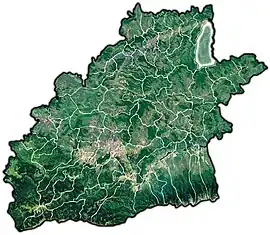Laslea
Laslea (German: Grosslasseln; Hungarian: Szászszentlászló) is a commune located in Sibiu County, Transylvania, Romania. It is composed of five villages: Florești (Felsendorf, Földszin), Laslea, Mălâncrav (Malmkrog, Almakerék), Nou Săsesc (Neudorf, Apaújfalu), and Roandola (Rauthal, Rudály). The route of the Via Transilvanica long-distance trail passes through the villages of Florești, Mălâncrav, and Nou Săsesc.[2]
Laslea | |
|---|---|
 Apafi manor in Mălâncrav | |
 Coat of arms | |
 Location in Sibiu County | |
 Laslea Location in Romania | |
| Coordinates: 46°13′N 24°39′E | |
| Country | Romania |
| County | Sibiu |
| Government | |
| • Mayor (2020–2024) | Ioan Onea (PSD) |
| Area | 113 km2 (44 sq mi) |
| Elevation | 351 m (1,152 ft) |
| Population (2011-10-31)[1] | 3,327 |
| • Density | 29/km2 (76/sq mi) |
| Time zone | EET/EEST (UTC+2/+3) |
| Postal code | 557115 |
| Area code | +40 x59 |
| Vehicle reg. | SB |
In Romanian, Florești was known as Felța until 1950.[3]
Geography
The commune is situated towards the center of the Transylvanian Plateau. It is located in the northeastern part of Sibiu County, on the border with Mureș County. It lies on the banks of the river Laslea, which discharges into the Târnava Mare near the village Laslea.
National road DN14 runs just north of the commune. The closest cities are Sighișoara, 13 km (8.1 mi) to the east, and Mediaș, 28 km (17 mi) to the west; the county capital, Sibiu, is 83 km (52 mi) to the southwest.
Demographics
At the 2011 census, Laslea had 3,327 inhabitants. Of those, 61% were Romanians, 30% Roma, 7.5% Germans, and 1% Hungarians. At the 2002 census, 76.2% were Romanian Orthodox, 7.2% Pentecostal, 5.7% Evangelical Lutheran, 5.2% Seventh-day Adventist, 2.6% Evangelical Church of Augustan Confession, and 1.2% Baptist.
Prince of Wales and sustainable tourism
In 2006, the Prince of Wales bought and restored two 18th-century Saxon houses in the villages of Mălâncrav and Viscri to help protect the unique way of life that has existed for hundreds of years and promote sustainable tourism.
The buildings have been sensitively restored and converted into guesthouses for tourists. They remain in keeping with the surrounding architecture and feature a number of Transylvanian antiques but with modern facilities where possible.
The renovation of these buildings has helped provide a sustainable future for the people of rural Transylvania while also enabling residents to maintain their traditional way of life.
Mălâncrav church gallery
 Exterior
Exterior The apse
The apse 15th-century altar
15th-century altar Apse ceiling
Apse ceiling Jesus with the Cross on the Via Dolorosa (apse)
Jesus with the Cross on the Via Dolorosa (apse) Hungarians saints: Bishop Gellert, King Ladislaus I, unknown, King Stephen I, his son Prince Emericus
Hungarians saints: Bishop Gellert, King Ladislaus I, unknown, King Stephen I, his son Prince Emericus
 Ceiling. Around the keystone, from bottom left (cw): birth of Jesus, Annunciation, the four Evangelists, Presentation in the Temple, ?
Ceiling. Around the keystone, from bottom left (cw): birth of Jesus, Annunciation, the four Evangelists, Presentation in the Temple, ? Mark the Evangelist (ceiling)
Mark the Evangelist (ceiling) The Last Supper and Christ washing the apostles' feet
The Last Supper and Christ washing the apostles' feet
See also
- Ghelința, St. Emeric Church: 13th-century murals
- Church on the Hill (Sighișoara), 14th-16th century murals
- Dârjiu, church murals from 1419
References
- "Populaţia stabilă pe judeţe, municipii, oraşe şi localităti componenete la RPL_2011" (XLS). National Institute of Statistics.
- "Terra Saxonum | Via Transilvanica". www.viatransilvanica.com (in Romanian). Retrieved 2023-08-14.
- Attila Szabó (ed.), Erdély, Bánság És Partium Történeti És Közigazgatási Helységnévtára. Miercurea Ciuc, 2003, Pro-Print Könyvkiadó, ISBN 973-8468-01-9
